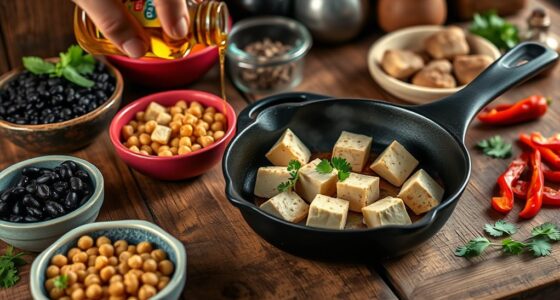Cooking with the seasons helps you maximize nutrition and flavor by focusing on fresh, in-season ingredients at their peak. By swapping out out-of-season produce for frozen or preserved options, you can enjoy nutritious foods year-round. Preserving seasonal flavors through freezing, canning, or drying extends their benefits and reduces waste. Incorporating these practices and ingredient swaps supports sustainable eating while boosting nutrient intake. Continue exploring how to make the most of each season’s bounty to keep your meals vibrant and nourishing.
Key Takeaways
- Prioritize in-season ingredients to maximize nutrient density and flavor throughout the year.
- Use preservation methods like freezing, canning, or drying to enjoy seasonal produce beyond harvest time.
- Swap out-of-season ingredients with frozen, dried, or local seasonal alternatives to maintain nutritional quality.
- Plan meals around seasonal produce to naturally diversify nutrient intake and support sustainable eating.
- Incorporate creative ingredient substitutions and preservation techniques to keep meals vibrant and nutrient-rich year-round.

Cooking with the seasons means embracing fresh, local ingredients at their peak flavor. When you adapt your meals to what’s in season, you not only enjoy ingredients at their freshest but also get the most nutrients possible. Seasonal ingredient swaps allow you to replace out-of-season produce with alternatives that are just as flavorful and nutrient-dense. For instance, if strawberries are out of season, you might use frozen berries or opt for seasonal fruits like apples or pears. This way, you keep your dishes vibrant and flavorful all year round. By doing so, you’re preserving seasonal flavors, which signifies capturing the essence of each harvest and making the most of what’s available. Preserving seasonal flavors through methods like freezing, canning, or drying ensures you can enjoy the taste and nutritional benefits long after the season ends. Incorporating high-quality ingredients such as color-protected or UV-filtered produce can further enhance the nutritional value of your meals.
Embrace seasonal ingredients and preserve flavors to enjoy peak nutrition and taste year-round.
This approach not only enhances the taste of your dishes but also boosts their nutritional value. Fresh, in-season produce tends to be richer in vitamins, minerals, and antioxidants, which can diminish as ingredients sit out of season or are transported over long distances. When you prioritize seasonal eating, you’re naturally inclined to include a broader range of nutrients in your diet, aligning your meals with what your body needs throughout the year. Furthermore, by incorporating seasonal ingredient swaps, you can experiment with new flavors and textures, keeping your cooking exciting and diverse. Think of swapping zucchini for summer squash or replacing winter root vegetables with fresh spring greens—these small changes can make a significant difference in taste and nutrition.
Preserving these seasonal flavors extends your enjoyment beyond the immediate harvest. Techniques like freezing berries, making jams, or drying herbs let you hold onto the freshness and nutrients of peak season produce. Not only does this help maintain the nutritional profile of your ingredients, but it also supports sustainable eating habits by reducing waste. When you plan your meals around seasonal ingredients and preserve their flavors, you create a cycle of freshness and sustainability that benefits both your health and the environment. Plus, it encourages you to get creative in the kitchen, finding new ways to enjoy familiar flavors year-round.
In the end, cooking with the seasons is about more than just taste; it’s about making smarter choices that maximize nutrition and reduce environmental impact. By embracing seasonal ingredient swaps and preserving seasonal flavors, you ensure each meal is packed with the best ingredients available, regardless of the time of year. This mindful approach keeps your diet diverse, flavorful, and nutrient-rich, making every bite a celebration of nature’s rhythm.
Frequently Asked Questions
How Can I Preserve Seasonal Produce for Off-Season Use?
You can preserve seasonal produce by using freezing techniques like blanching vegetables before storing them in airtight containers. For fruits, freezing or making jams works well. Canning methods, such as water bath or pressure canning, are great for longer-term storage of sauces and preserves. These techniques lock in nutrients and flavor, so you can enjoy fresh-tasting produce even when it’s out of season. Just follow proper safety guidelines for each method.
What Are the Best Storage Methods for Seasonal Fruits and Vegetables?
You should store seasonal fruits and vegetables by freezing fruits like berries and peaches to preserve freshness. For root vegetables, consider root cellaring in a cool, dark, and humid space to keep them fresh longer. These methods help you enjoy seasonal produce year-round, ensuring maximum nutrition. Proper storage prevents spoilage and maintains flavor, so you can savor the tastes of each season whenever you want.
How Do Seasonal Eating Habits Vary Across Different Regions?
You notice that seasonal eating habits differ across regions due to regional preferences and cultural influences. In warmer areas, you might enjoy more tropical fruits and salads, while colder regions favor hearty stews and root vegetables. Cultural traditions shape what you eat seasonally, guiding your choices based on local harvests and customs. Embracing these differences helps you enjoy a diverse, nutritious diet tailored to your region’s unique climate and culture.
Are There Any Seasonal Foods to Avoid Due to Pesticides?
You might wonder if certain seasonal foods should be avoided due to pesticide residues. Research shows that produce like strawberries, spinach, and apples often have higher pesticide levels, especially when conventionally grown. To reduce exposure, choose organic options when possible, particularly during their peak seasons. Always wash produce thoroughly, and consider buying from local farmers who use fewer chemicals. This way, you enjoy fresh, nutritious foods safely year-round.
How Can I Introduce Seasonal Eating Into a Busy Lifestyle?
To introduce seasonal eating into your busy lifestyle, start with simple meal planning that highlights seasonal produce. Opt for quick recipes that use fresh, in-season ingredients, like salads or stir-fries, to save time. Keep a rotating list of seasonal favorites and prep ingredients ahead of time. This way, you can enjoy nutritious, flavorful meals without sacrificing your schedule, making healthy eating effortless and sustainable year-round.
Conclusion
Think of your kitchen as a vibrant garden that blooms year-round. By choosing seasonal ingredients, you become the diligent gardener nurturing your body’s needs, harvesting the freshest, most nourishing flavors at just the right time. When you cook with the seasons, you’re tending a garden of wellness, reaping vibrant health and energy. So, embrace this culinary cycle, and let each meal be a harvest of vitality, fueling your life like a well-tended garden in full bloom.








